Esau
Esau[lower-alpha 1] in the Hebrew Bible, is the older son of Isaac. He is mentioned in the Book of Genesis,[3] and by the prophets Obadiah[4] and Malachi.[5] The New Testament alludes to him in the Epistle to the Romans[6] and in the Epistle to the Hebrews.[7]
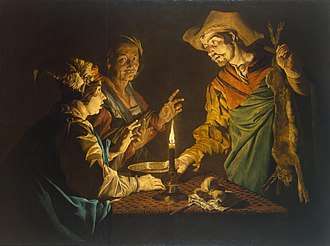
According to the Hebrew Bible, Esau is the progenitor of the Edomites and the elder brother of Jacob, the patriarch of the Israelites.[8] Esau and Jacob were the sons of Isaac and Rebekah, and the grandsons of Abraham and Sarah. Of the twins, Esau was the first to be born with Jacob following, holding his heel. Isaac was sixty years old when the boys were born.
Esau, a "man of the field", became a hunter[1] who had "rough"[2] qualities that distinguished him from his twin brother. Among these qualities were his redness and noticeable hairiness.[9] Jacob was a plain or simple man, depending on the translation of the Hebrew word tam (which also means "relatively perfect man"). Jacob's color was not mentioned.[8] Throughout Genesis, Esau is frequently shown as being supplanted by his younger twin, Jacob (Israel).[10]
In Genesis
Birth
Genesis 25:25 narrates Esau's birth, "Now the first came forth red, all over like a hairy garment; and they named him Esau."[11] The meaning of the word esau is disputed. It could be related to the Arabic root ġšw, meaning "to cover".[12] Others have noted the similarity to Arabic ’athaa (عثا) meaning "hirsute".[13] In Hebrew, the word "hairy" (Heb: se’ir) is a wordplay on Seir,[10] the region in which he settled after being 40 years of age. The name Edom is also attributed to Esau, meaning "red" (Heb: `admoni);[10] the same color used to describe Esau's skin tone.[14] Genesis parallels his redness to the "red lentil pottage" that he sold his birthright for.[15][1] Esau became the progenitor of the Edomites in Seir.
Birthright
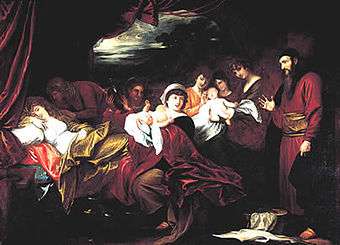
In Genesis, Esau returned to his twin brother Jacob, famished from the fields. He begs Jacob to give him some "red pottage" (a play on his nickname, Hebrew: אדום`Edom, meaning "red".) This refers to his red hair.[16] Jacob offers Esau a bowl of lentil stew[lower-alpha 2] in exchange for Esau's birthright (Hebrew: בְּכֹרָה bəḵōrāh, the right to be recognized as firstborn son with authority over the family), and Esau agrees. Thus Jacob acquires Esau's birthright. This is the origin of the English phrase "for a mess of pottage".
In Genesis 27:1–40, Jacob uses deception, motivated by his mother Rebecca, to lay claim to his blind father Isaac's blessing that was inherently due to the firstborn, Esau.
In Genesis 27:5–7, Rebecca is listening while Isaac speaks to his son Esau. When Esau goes to the field to hunt for venison to bring home, Rebekah says to her son Jacob, "Behold, I heard thy father speak to thy brother Esau, saying: 'Bring me venison and prepare a savoury food, that I may eat, and bless thee before the Lord before my death.'" Rebecca then instructs Jacob in an elaborate deception through which Jacob pretends to be Esau, in order to steal from Esau his blessing from Isaac and his inheritance—which in theory Esau had already agreed to give to Jacob. Jacob follows through with the plan to steal his brother's birthright by bringing the meal his father Isaac requested and pretending to be Esau. Jacob pulled off his disguise by covering himself in hairy lamb skin so that when his blind father went to touch him, his smooth skin did not give him away as an imposter of his hairy brother. Jacob successfully received his father Isaac's blessing. As a result, Jacob becomes the spiritual leader of the family after Isaac's death and the heir of the promises of Abraham (Genesis 27:37).
When Esau learns of his brother's thievery, he is livid and begs his father to undo the blessing. Isaac responds to his eldest son's plea by saying that he only had one blessing to give and that he could not reverse the sacred blessing. Esau is furious and vows to kill Jacob (Genesis 27:41). Once again Rebecca intervenes to save her younger son from being murdered by his elder twin brother, Esau.
Therefore, at Rebecca's urging, Jacob flees to a distant land to work for his uncle Laban (Genesis 28:5). Jacob does not immediately receive his father's inheritance after the impersonation aimed at taking it from Esau. Having fled for his life, Jacob has left the wealth of Isaac's flocks, land and tents in Esau's hands. Jacob is forced to sleep out on the open ground and then work for wages as a servant in Laban's household. Jacob, who had deceived and cheated his brother, is in turn deceived and cheated by his uncle. Jacob asks to marry Laban's daughter Rachel, whom he has met at the well, and Laban agrees, if Jacob will give him seven years of service. Jacob does so, but after the wedding finds that beneath the veil is not Rachel but Leah, Laban's elder daughter. He agrees to work another seven years and Jacob and Rachel are finally wed. However, despite Laban, Jacob eventually becomes so rich as to incite the envy of Laban and Laban's sons.
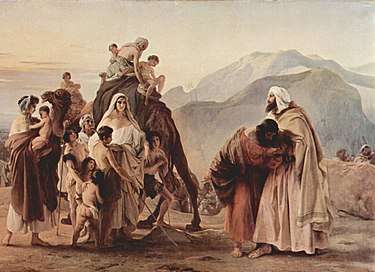
Genesis 32–33 tells of Jacob's and Esau's eventual reconciliation. Jacob sends multiple waves of gifts to Esau as they approach each other, hoping that Esau will spare his life. Esau refuses the gifts, as he is now very wealthy and does not need them. Jacob never apologizes to Esau for his actions; Jacob nevertheless bows down before Esau and insists on his receiving the gifts. Esau shows forgiveness in spite of this bitter conflict. (After this, God confirms his renaming of Jacob as "Israel".)
Jacob's deception
Genesis Chapter 27 verse 16 of the King James Version Bible: "And she put the skins of the kids of the goats upon his hands and upon the smooth of his neck:" Verse 19: "And Jacob said unto his father, I am Esau thy firstborn; I have done according as thou badest me: arise, I pray thee, sit and eat of my venison, that thy soul may bless me." Verse 22-23: "And Jacob went near unto Isaac his father; and he felt him, and said, The voice is Jacob's voice, but the hands are the hands of Esau. And he discerned him not, because his hands were hairy, as his brother Esau's hands: so he blessed him."
Family
Genesis 26:34–35 describes Esau's marriage at the age of forty to two Canaanite women: Judith the daughter of Beeri the Hittite, and Basemath the daughter of Elon the Hittite. This arrangement grieved his parents.[17] Upon seeing that his brother was blessed and that their father rejected Esau's union to Canaanites, Esau went to the house of his uncle Ishmael and married his cousin,[18] Mahalath the daughter of Ishmael, and sister of Nebajoth. Esau's family is again revisited in Genesis 36, this passage names two Canaanite wives; Adah, the daughter of Elon the Hittite, and Aholibamah, the daughter of Anah, daughter of Zibeon the Hivite, and a third: Bashemath, Ishmael's daughter, sister of Nebajoth. Some scholars equate the three wives mentioned in Genesis 26 and 28 with those in Genesis 36.[19][20] Casting his lot with the Ishmaelites, he was able to drive the Horites out of Mount Seir to settle in that region.[1] According to some views Esau is considered to be the progenitor not only of the Edomites but of the Kenizzites and the Amalekites as well.[21][22]
Esau had five sons:[23]
Family tree
| Family of Esau | |||||||||||||||||||||||||||||||||||||||||||||||||||||||||||||||||||||||||||||||||||||||||||||||||||||||||||||||||||||||||||||||||||||||||||||||||||||||||||||||||||||||||||||||||||||||||||||||||||||||||||||||||||||||||||||||||||||||||||||||||||||||||||||||||||||||||||||||||||||||||||||||||||||||||||||||||||||||||||||||||||||||||||||||||||||||||||||||||||||||||||||||||||||||||||||||||||||||||||||||||||||||||||||||||||||||||||||||||||||||||||||||||||||||||||||||||||||||||||||||||||||||||||||||||||||||||||||||||||||||||||||||||||||||||||||||||||||||||||||||||||||||||||||||||||||||||||||||||||||||||||||||||||||||||||||||||||||||||||||||||||||||||||||||||||||||||||||||||||||||||||||||||||||||||||||||||||||||||||||||||||||||||||||||||||||||||||||||||||||||||||||||||||||||||||||||||||||||||||||||||||||||||||||||||||||||||||||||||||||||||||||||||||||||||||||||||||||||||||||||||||||||||||||||||||||||||||||||||||||||||||||||||||||||||||||||||||||||||||||||||||||||||||||||||||||||||||||||||||||||
|---|---|---|---|---|---|---|---|---|---|---|---|---|---|---|---|---|---|---|---|---|---|---|---|---|---|---|---|---|---|---|---|---|---|---|---|---|---|---|---|---|---|---|---|---|---|---|---|---|---|---|---|---|---|---|---|---|---|---|---|---|---|---|---|---|---|---|---|---|---|---|---|---|---|---|---|---|---|---|---|---|---|---|---|---|---|---|---|---|---|---|---|---|---|---|---|---|---|---|---|---|---|---|---|---|---|---|---|---|---|---|---|---|---|---|---|---|---|---|---|---|---|---|---|---|---|---|---|---|---|---|---|---|---|---|---|---|---|---|---|---|---|---|---|---|---|---|---|---|---|---|---|---|---|---|---|---|---|---|---|---|---|---|---|---|---|---|---|---|---|---|---|---|---|---|---|---|---|---|---|---|---|---|---|---|---|---|---|---|---|---|---|---|---|---|---|---|---|---|---|---|---|---|---|---|---|---|---|---|---|---|---|---|---|---|---|---|---|---|---|---|---|---|---|---|---|---|---|---|---|---|---|---|---|---|---|---|---|---|---|---|---|---|---|---|---|---|---|---|---|---|---|---|---|---|---|---|---|---|---|---|---|---|---|---|---|---|---|---|---|---|---|---|---|---|---|---|---|---|---|---|---|---|---|---|---|---|---|---|---|---|---|---|---|---|---|---|---|---|---|---|---|---|---|---|---|---|---|---|---|---|---|---|---|---|---|---|---|---|---|---|---|---|---|---|---|---|---|---|---|---|---|---|---|---|---|---|---|---|---|---|---|---|---|---|---|---|---|---|---|---|---|---|---|---|---|---|---|---|---|---|---|---|---|---|---|---|---|---|---|---|---|---|---|---|---|---|---|---|---|---|---|---|---|---|---|---|---|---|---|---|---|---|---|---|---|---|---|---|---|---|---|---|---|---|---|---|---|---|---|---|---|---|---|---|---|---|---|---|---|---|---|---|---|---|---|---|---|---|---|---|---|---|---|---|---|---|---|---|---|---|---|---|---|---|---|---|---|---|---|---|---|---|---|---|---|---|---|---|---|---|---|---|---|---|---|---|---|---|---|---|---|---|---|---|---|---|---|---|---|---|---|---|---|---|---|---|---|---|---|---|---|---|---|---|---|---|---|---|---|---|---|---|---|---|---|---|---|---|---|---|---|---|---|---|---|---|---|---|---|---|---|---|---|---|---|---|---|---|---|---|---|---|---|---|---|---|---|---|---|---|---|---|---|---|---|---|---|---|---|---|---|---|---|---|---|---|---|---|---|---|---|---|---|---|---|---|---|---|---|---|---|---|---|---|---|---|---|---|---|---|---|---|---|---|---|---|---|---|---|---|---|---|---|---|---|---|---|---|---|---|---|---|---|---|---|---|---|---|---|---|---|---|---|---|---|---|---|---|---|---|---|---|---|---|---|---|---|---|---|---|---|---|---|---|---|---|---|---|---|---|---|---|---|---|---|---|---|---|---|---|---|---|---|---|---|---|---|---|---|---|---|---|---|---|---|---|---|---|---|---|---|---|---|---|---|---|---|---|---|---|---|---|---|---|---|---|---|---|---|---|---|---|---|---|---|---|---|---|---|---|---|---|---|---|---|---|---|---|---|---|---|---|---|---|---|---|---|---|---|---|---|---|---|---|---|---|---|---|---|---|---|---|---|---|---|---|---|---|---|---|---|---|---|---|---|---|---|---|---|---|---|---|---|---|---|---|---|---|---|---|---|---|---|---|---|---|---|---|---|---|---|---|---|---|---|---|---|---|---|---|---|---|---|---|---|---|---|---|---|---|---|---|---|---|---|---|---|---|---|---|---|---|---|---|---|---|---|---|---|---|---|---|---|---|---|---|---|---|---|---|---|---|---|---|---|---|---|---|---|---|---|---|---|---|---|---|---|---|---|---|---|---|---|---|---|---|---|---|---|---|---|---|---|---|---|---|---|---|---|---|---|---|---|---|---|---|---|---|---|---|---|---|---|---|---|---|---|---|---|---|---|---|---|---|---|---|---|---|---|---|---|---|---|---|---|---|---|---|---|---|---|---|---|---|---|---|---|---|---|---|---|---|---|---|---|---|---|---|---|---|---|---|---|---|---|---|---|---|---|---|---|---|---|---|---|---|---|---|---|---|---|---|---|---|---|---|---|---|---|---|---|---|---|---|---|---|---|---|---|---|---|---|---|---|---|---|---|---|---|---|---|---|---|---|---|---|---|---|---|---|---|---|---|---|---|---|---|---|---|---|---|---|---|---|---|---|---|---|---|
| |||||||||||||||||||||||||||||||||||||||||||||||||||||||||||||||||||||||||||||||||||||||||||||||||||||||||||||||||||||||||||||||||||||||||||||||||||||||||||||||||||||||||||||||||||||||||||||||||||||||||||||||||||||||||||||||||||||||||||||||||||||||||||||||||||||||||||||||||||||||||||||||||||||||||||||||||||||||||||||||||||||||||||||||||||||||||||||||||||||||||||||||||||||||||||||||||||||||||||||||||||||||||||||||||||||||||||||||||||||||||||||||||||||||||||||||||||||||||||||||||||||||||||||||||||||||||||||||||||||||||||||||||||||||||||||||||||||||||||||||||||||||||||||||||||||||||||||||||||||||||||||||||||||||||||||||||||||||||||||||||||||||||||||||||||||||||||||||||||||||||||||||||||||||||||||||||||||||||||||||||||||||||||||||||||||||||||||||||||||||||||||||||||||||||||||||||||||||||||||||||||||||||||||||||||||||||||||||||||||||||||||||||||||||||||||||||||||||||||||||||||||||||||||||||||||||||||||||||||||||||||||||||||||||||||||||||||||||||||||||||||||||||||||||||||||||||||||||||||||||
Other references
Minor prophet references
Esau was also known as Edom, the progenitor of the Edomites who were established to the south of the Israelites. They were an enemy nation of Israel.[25] The minor prophets, such as Obadiah, claim that the Edomites participated in the destruction of the First Temple by Nebuchadnezzar in 587 BC. Exactly how the Edomites participated is not clear. Psalm 137 ("By the waters of Babylon") suggests merely that Edom had encouraged the Babylonians: The Lord is asked to "remember against the Edomites the day of Jerusalem, how they said 'raze it, raze it to its foundations'".[26] But the prophecy of Obadiah insists on the literal "violence done" by Esau "unto your brother Jacob" when the Edomites "entered the gate of my people..., looted his goods..., stood at the parting of the ways to cut off the fugitive,... delivered up his survivors on his day of distress".[27]
By the intertestamental period, Edom had replaced Babylon as the nation that actually burned the Temple ("Thou hast also vowed to build thy temple, which the Edomites burned when Judah was laid waste by the Chaldees" [28]).
New Testament references
Hebrews 12:15–16 depicts Esau as unspiritual for thoughtlessly throwing away his birthright. Romans 9:13 states "Jacob I loved, but Esau I hated," based upon Malachi 1:2-3 although this passage goes on to depict the nations of Israel (Jacob) and Edom (Esau).
Rabbinic Jewish sources
The Targum Pseudo-Jonathan connects the name Esau to the Hebrew asah, stating, "because he was born fully completed, with hair of the head, beard, teeth, and molars."[29] Other traditional sources connect the word with the Hebrew šāv` (Hebrew: שָׁוְא) meaning "worthless."[30]
Jewish commentaries have shed a negative view on Esau because of his rivalry with Jacob. The Midrash says that during Rebekah's pregnancy whenever she would pass a house of Torah study, Jacob would struggle to come out; whenever she would pass a house of idolatry, Esau would agitate to come out.[31]
He is considered to be a rebellious son who kept a double life until he was 15, when he sold his birthright to Jacob. According to the Talmud, the sale of the birthright took place immediately after Abraham died.[32] The Talmudic dating would give both Esau and Jacob an age of 15 at the time. The lentils Jacob was cooking were meant for his father Isaac, because lentils are the traditional mourner's meal for Jews. On that day before returning, in a rage over the death of Abraham, Esau committed five sins; he raped a betrothed young woman, he committed murder (Nimrod), he denied God, he denied the resurrection of the dead, and he spurned his birthright.[33]
Haman's lineage is given in the Targum Sheni as follows: "Haman the son of Hammedatha the Agagite, son of Srach, son of Buza, son of Iphlotas, son of Dyosef, son of Dyosim, son of Prome, son of Ma'dei, son of Bla'akan, son of Intimros, son of Haridom, son of Sh'gar, son of Nigar, son of Farmashta, son of Vayezatha, (son of Agag, son of Sumkei,) son of Amalek, son of the concubine of Eliphaz, firstborn son of Esau".
According to Rashi, Isaac, when blessing Jacob in Esau's place, smelled the heavenly scent of Gan Eden (Paradise) when Jacob entered his room and, in contrast, perceived Gehenna opening beneath Esau when the latter entered the room, showing him that he had been deceived all along by Esau's show of piety.[34]
Death
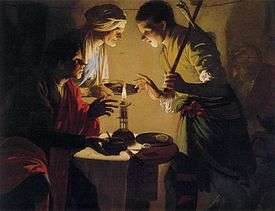
According to the Babylonian Talmud, Esau was killed by Hushim, son of Dan, son of Jacob, because Esau obstructed the burial of Jacob into the cave of Machpelah. When Jacob was brought to be buried in the cave, Esau prevented the burial, claiming he had the right to be buried in the cave; after some negotiation Naphtali was sent to Egypt to retrieve the document stating Esau sold his part in the cave to Jacob. Hushim (who was hard of hearing) did not understand what was going on, and why his grandfather was not being buried, so he asked for an explanation; after being given one he became angry and said: "Is my grandfather to lie there in contempt until Naphtali returns from the land of Egypt?" He then took a club and killed Esau, and Esau's head rolled into the cave.[35] This means that the head of Esau is also buried in the cave.
Jewish sources state that Esau sold his right to be buried in the cave. According to Shemot Rabbah, Jacob gave all his possessions to acquire a tomb in the Cave of the Patriarchs. He put a large pile of gold and silver before Esau and asked, “My brother, do you prefer your portion of this cave, or all this gold and silver?”[36] Esau's selling to Jacob his right to be buried in the Cave of the Patriarchs is also recorded in Sefer HaYashar.[37]
Jubilees
In the Book of Jubilees, Esau's father, Isaac, compels Esau to swear not to attack or kill Jacob after Isaac has died. However, after the death of Isaac, the sons of Esau convince their father to lead them, and hired mercenaries, against Jacob in order to kill Jacob and his family and seize their wealth (especially the portion of Isaac's wealth that Isaac had left to Jacob upon his death). "Then Ya'aqov bent his bow and sent forth the arrow and struck Esau, his brother on his right breast and slew him (Jubilees 38:2) . . . Ya'aqov buried his brother on the hill which is in Aduram, and he returned to his house (Jubilees 38:9b)." [38]
Reputed grave on the West Bank
South of the Palestinian town of Sa'ir on the West Bank there is a tomb reputed to be that of Esau – El 'Ais in his Arab name.
The PEF's Survey of Western Palestine (SWP), wrote that: "The tomb is in a chamber 37 feet east and west by 20 feet north and south, with a Mihrab on the south wall. The tomb is 12 feet long, 3 1/2 feet broad, 5 feet high, covered with a dark green cloth and a canopy above. An ostrich egg is hung near. North of the chamber is a vaulted room of equal size, and to the east is an open court with a fig-tree, and a second cenotaph rudely plastered, said to be that of Esau's slave. Rock-cut tombs exist south-west of this place."[39]
The SWP stated this identification was false and that Esau's tomb was in the Biblical Mount Seir.[40][41][42]
Gallery
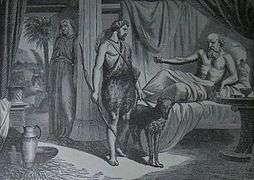 Esau Going for Venison (illustration from the 1890 Holman Bible)
Esau Going for Venison (illustration from the 1890 Holman Bible)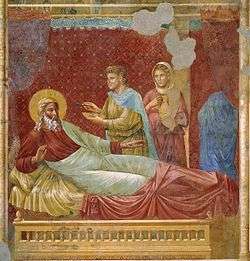 Isaac upon Esau's Return (fresco circa 1292–1294 by Giotto di Bondone)
Isaac upon Esau's Return (fresco circa 1292–1294 by Giotto di Bondone).jpg) Birth of Esau and Jacob (illumination circa 1475–1480 by François Maitre from Augustine's La Cité de Dieu, at the Museum Meermanno-Westreenianum)
Birth of Esau and Jacob (illumination circa 1475–1480 by François Maitre from Augustine's La Cité de Dieu, at the Museum Meermanno-Westreenianum)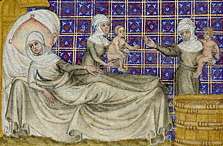 The Birth of Esau and Jacob (illumination by Master of Jean de Mandeville, Paris, from a Bible Historiale c. 1360–1370)
The Birth of Esau and Jacob (illumination by Master of Jean de Mandeville, Paris, from a Bible Historiale c. 1360–1370)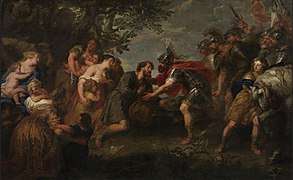 The reconciliation of Jacob and Esau (1640 painting by Jan van den Hoecke)
The reconciliation of Jacob and Esau (1640 painting by Jan van den Hoecke)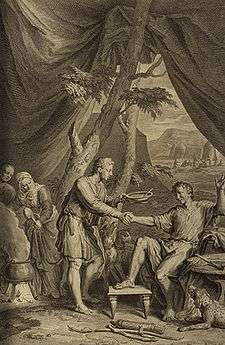 Esau Sells His Birthright (from the 1728 Figures de la Bible)
Esau Sells His Birthright (from the 1728 Figures de la Bible)
Notes
References
- Easton, M. Illustrated Bible Dictionary, (ISBN 1596059478, ISBN 978-1-59605-947-4, 2006, p. 236
- Mandel, D. The Ultimate Who's Who in the Bible, (ISBN 0882703722.ISBN 978-0-88270-372-5), 2007, p. 175
- Genesis 25
- Obadiah 1:8–21
- Malachi 1:2,3
- Romans 9:13
- Hebrews 11:20,12:16
- Metzger & Coogan (1993). Oxford Companion to the Bible, pp. 191–92.
- Genesis 25:25
- Attridge & Meeks. The Harper Collins Study Bible, (ISBN 0060786841, ISBN 978-0-06-078684-7 ), 2006, p. 40
- Genesis 25:25
- "Esau". Jewish Virtual Library. Retrieved 28 August 2015.
- Bartlett, J.R. (4 October 1977). "The Brotherhood of Edom". Journal for the Study of the Old Testament. 2 (4): 26. doi:10.1177/030908927700200401.
- Genesis 25:25
- Genesis 25:30
- Genesis 25:25
- Genesis 26:34–35
- Mandel. Ultimate Who's Who, p. 176
- Phillips. Exploring Genesis, p. 284
- Jamieson-Fausset-Brown. Commentary Critical and Explanatory on the Whole Bible
- "Caleb". Retrieved 8 October 2014.
- "Amalekites". Retrieved 8 October 2014.
- Genesis 36:4–5
- Genesis 22:21-22: Uz, Buz, Kemuel, Chesed, Hazo, Pildash, and Jidlaph
- Peter Ackroyd, Exile and Restoration: A Study in Hebrew Thought of the Sixth Century B.C., 1968, p. 224.
- Psalm 137:7
- Obadiah 10:13–14
- 1 Esdras 4:45
- Anderson, Bradford A. (2011). Brotherhood and Inheritance: A Canonical Reading of the Esau and Edom Traditions. T&T Clark International. p. 35. ISBN 9780567368256.
- Anderson, Bradford A. (2011). Brotherhood and Inheritance: A Canonical Reading of the Esau and Edom Traditions. T&T Clark International. p. 35. ISBN 9780567368256.
- Bereshit Rabbah 63:6.
- Bava Batra 16b.
- Bava Batra 16b
- Pirkei d'Rav Kahana, quoted in Scherman, p. 139.
- Sotah 13a
- Shemot Rabbah 31:17
- Sefer Hayashar Chapter 27 p. 77b
- “Verses Two & Nine.” Cepher, 3rd ed., Cepher Publishing Group, LLC, 2017, pp. 255–256.
- "The survey of western Palestine : memoirs of the topography, orography, hydrography, and archaeology". archive.org.
- Conder and Kitchener, 1883, p. 309 Archived October 20, 2016, at the Wayback Machine
- Conder, 1881, p. 215 Archived April 21, 2016, at the Wayback Machine–6 in PEFQS
- Conder, 1889, p. 123 Archived April 3, 2016, at the Wayback Machine–4 in PEFQS
Bibliography
- Metzger, Bruce M.; Coogan, Michael D., eds. (1993). The Oxford Companion to the Bible. Oxford, UK: Oxford University Press. ISBN 978-0-19-504645-8.
External links
| Wikimedia Commons has media related to Esau. |
- Esau at the Jewish Encyclopedia
- . Encyclopædia Britannica (11th ed.). 1911.